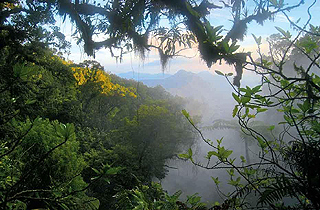Climbing up a volcano through a dark, muggy rainforest in the middle of the night may not
As we journey deeper into the forest the smells and sounds amplify.

We are walking through the Gunung Gede Pangrango National Park, near Bogor in Indonesia, trying to keep up with our guide, Abi. We had originally planned a day trek but were intrigued by the idea of a nocturnal expedition, which apparently few people choose to experience. There was also the prospect of watching dawn break from the peak of a volcano. The icing on the cake was the promise of a plunge into one of the park’s famous hot springs. So, just before midnight we fuelled up on nasi goreng and strong black coffee. Shortly thereafter we were headed up to the entrance of the park.
The previous day we had trekked up to the spectacular triple Cibeureum Waterfalls in the park, the tallest fifty metres high.
The surrounding forest was a dense mosaic of tropical life: enormous bird’s-nest ferns, trees emerging like skyscrapers from rocky buttresses, moss- and lichen-laden trunks, multicoloured butterflies fluttering around. But splendid as it was, it was nature invaded. It was a Sunday afternoon, when hordes of people had fled the concrete jungle of Jakarta. They were traipsing up and down the path to the waterfall, their cellphones blaring out the latest pop music, hardly anyone glancing at the wonders of the forest around them.
Just after midnight we found ourselves on that same path, the human cacophony of daytime replaced with the multifarious, more mysterious sounds of a forest at night: the rustle of leaves, the creak of bamboo, the repetitive sirens of cicadas and the croaking of frogs. As we veered away from the main path to start climbing the volcano there were long stretches of deep silence broken only by our laboured breathing or the occasional exclamation from one of us at the unfolding splendour around us.

Halfway up the mountain, we stopped to rest, while Abi told us about the park. Established in 1980, the Gunung Gede National Park is nearly 220 sq km big. It comprises a stratovolcano with two peaks—Mount Gede and Mount Pangrango—clad on all sides by forest that thins to cultivated plains below. One of the peaks erupted not so long ago and although it didn’t rain ash or pour out lava—it just sent out towering plumes of smoke—it felt both strange and exhilarating to know we were climbing a volcano which was still very much alive.
The creatures we saw on our night walk were but a fraction of the vast biological diversity the park contains—Indonesia has the second highest known biodiversity in the world. From the base to the top there is a range of ecosystems, including marsh, lake, grassland and a variety of forest types. There are at least 250 species of birds together with some of Indonesia’s most threatened species of mammals, including the Javan gibbon. International recognition of the park’s importance means that it is now included on Unesco’s Biosphere Reserve list. At its base there is also the renowned Cibodas Botanical Gardens, over a hundred and fifty years old and containing over two thousand specimens from around the world.
Five tiring hours into the climb, we were informed by Abi that the hot springs were near. He warned us that we must hold on to a rope strung (very precariously we later found out) along the path, as we traversed the springs, and that we must not step into the water at the first spring because the temperature was over 60 degrees Celsius! We were sceptical about his claim, particularly at this altitude where the night air was so chilly. But, as we rounded a bend, we encountered swirling steam rising in great clouds into the dim moonlight. Like the steam, our scepticism evaporated into the cool night. The hot spring was really a stream running alongside the path which we negotiated via the slipperiest of stones. Our spectacles continually fogged up, adding to our sense of disorientation and wonder. The precarious rope, which we had previously mocked, was a godsend—it would have been impossible to get to the second spring without it.

Gratifyingly, the temperature of the water in the second spring was perfect. Braving the chilly dawn air we changed into swimming gear and a few moments later our aching limbs were immersed in warm, therapeutic volcanic water, flowing down in a gentle waterfall. In the water we reclined on huge, solid rocks smooth as polished mangoes—boulders that had probably been there for hundreds, if not thousands, of years.
We could have stayed there forever but dawn was breaking and the best vantage point was a little further up, from where we could enjoy a panoramic view of the valley below. It was glorious: a peeping sun banishing the darkness; shades of white and yellow and pink splashing the horizon like brushstrokes by a wildly creative artist. Solitary, tentative bird calls gradually rising to a symphonic dawn chorus crescendo. The forest below slowly coming into focus and around us soft wisps of steam rising and disappearing into the strengthening light. An unforgettable daybreak.
Sadly, this was also our cue to head back to the pedestrian world below. We had a flight to catch: Jakarta beckoned—a modern, surreal contrast to this natural beauty. On the way down, we were greeted by a group of orange and brown Javan langurs feeding, grooming and playing in the tree canopy above us in the early morning light. We lingered a few moments, quietly taking in a scene that has probably changed little in all the time that humans have been around. And we were grateful that there still exist places such as this.
Gunung Gede Pangrango National Park
Indonesia
west Java


